Article

Interpretation of the 2023 Government Work Report & Industry Outlook
Published date: March 20, 2023
Every year, the Two Sessions are closely watched as the government sets out its key economic targets and policy directives. 2023 has been no exception, although investor sentiment has been buoyed by an expected recovery in the wake of China's reopening and a slew of policies aimed at reflating the economy and reigniting private investment. This year, a new premier and his economic team will also unveil the policy areas they will focus on. As a result, the Two Sessions will carry greater significance than that of 2022. In this report, we will deliver an outlook on China’s future policy priorities from both a macroeconomic and industry perspectives, as well as the development opportunities for industries and enterprises, based on our long-term observations of the Chinese economy.
Economic Outlook
The GDP growth target for 2023 was set at "around 5%". This conservative growth target will leave the new economic team, led by Li Qiang, with more policy wiggle room. More importantly, a more feasible target implies a policy bias towards consumption instead of investment. In recent years, policymakers have been making efforts to increase the quality of growth by deviating from a binding growth target which was being perceived as a confidence booster in the past. There are many good reasons for China to pivot to a more sustainable growth path due to a build-up of debt from previous fiscal stimuluses and a worsening demographic profile to name couple of headwinds. However, for local governments, GDP growth remains a viable KPI. Therefore, “around 5%” entails wiggle room and appears a very attenable target (we have revised our previous forecast from 4.5% to 5% after the Chinese New Year on the basis of a strong consumption recovery in 2023 which we now believe is more likely).
Even with favourable base effects from 2022, a smooth recovery should by no means be taken for granted. That is why Dr Yi Gang, who will stay on as PBOC Governor, has discussed the rationale for China not to follow rate hikes in developed countries. Yi's appointment also came on the heels of Silicon Valley Bank's failure. Global financial markets remain in an unsettled stage despite decisive action taken by the Federal Reserve and the FDIC in the US. Against this backdrop of further financial stresses from SVB, a reorganization of regulatory agencies aimed at streamlining overlapping oversight is sensible.
To paraphrase Premier Li Qiang’s debut press conference on March 13, "ordinary people often pay attention to their daily lives, not to GDP". Indeed, setting a higher job creation target of 12 million in 2023 vs 11 million in 2022 sends a strong signal of promoting more labor-intensive sectors, implying more emphasis on the services sector because large infrastructure projects may not entail more job creation. Therefore, policy assurances on the platform economy are necessary for reigniting the private sector's animal spirits.
A moderate increase of fiscal deficit/GDP from 2.8% to 3.2% indicates that the fiscal stance will be looser but not excessively so.
With less emphasis on the mantra that "homes are for living in, not for speculation” in the Government Work Report this year, we expect more supportive measures to ease the property sector (e.g., easier mortgage terms) which effectively means policy encouragement for higher consumer leverage.
All in all, the Two Sessions have taken another step to de-emphasize the GDP growth target. Such an approach is prudent given that major central banks are struggling to deal with a tight labor market and potential financial stresses at the same time.
Key targets for 2023

Source: Report on the Work of the Government, Deloitte Research
New round of institutional reform: strengthen the central leadership, optimize the division of functions, and promote the efficiency of cooperation governance.
The CPC Central Committee and the State Council recently released a plan on reforming Party and state institutions, which is not only a continuation of the reform of Party and State institutions since the 18th CPC National Congress, but also establishes a new framework for new tasks on the new journey of the new era after the 20th CPC National Congress. The reform states the aim of two long-term strategic goals, which are the modernization of China's system and governance capacity and building a high-level socialist market economy. The plan includes nineteen initiatives in five key sectors, five of which aim to deepen reforms on CPC Central Committee institutions, eleven to deepen reforms on the State Council institutions, one each to deepen the institutional reforms of the NPC and the CPPCC National Committee, and to optimize the allocation of resources for institutional staffing. Central authorities are expected to complete the reforms by the end of 2023, while localities are expected to complete the reforms by the end of 2024. It is expected that a detailed plan and accompanying documents will be issued within this year.
To deepen institutional reforms of the CPC Central Committee, five new central agencies have been set up to strengthen the CPC Central Committee's centralized and unified leadership over work related to finance, science and technology, Hong Kong-Macao, petition and party building. The Central Commission for Comprehensively Deepening Reform, the Central Cyberspace Affairs Commission, the Central Commission for Financial and Economic Affairs, and the Central Foreign Affairs Commission were established during the eighth round of reform in 2018. In this latest round of reform, five new central agencies have been established, which are the Central Commission for the Financial System, the Central Commission for Party Building in the Financial System, the Central Commission for Science and Technology, the Central Department for Social Work, and the Central Office for Hong Kong and Macao Affairs. Shortly afterwards the official English names of the five agencies will be brought out.
On deepening reform of State Council institutions, the current reform included 11 items, including restructuring the Ministry of Science and Technology (MOST), setting up a National Financial Regulatory Administration (NFRA), establishing a National Data Bureau (NDB) and improving the management mechanism for intellectual property rights (IPR), as well as seven other items. This is the ninth round of institutional reform of the State Council since reform and opening-up began. After this round of reform, the number of departments under the State Council remains unchanged at 26, among which the responsibilities of MOST, the Ministry of Agriculture and Rural Affairs (MARA), the People's Bank of China (PBOC), the National Health Commission (NHC) and the Ministry of Civil Affairs (MCA) have been optimized and adjusted. The number of agencies directly under the State Council has increased from 11 to 14, with the National Rural Revitalization Administration (NRRA) reduced and the newly formed National Financial Regulatory Administration(NFRA) added, as well as the revamped China Securities Regulatory Commission (CSRC), the National Public Complaints and Proposals Administration (NPCPA), and the China National Intellectual Property Administration (CNIPA). The number of public institutions directly under the State Council was reduced from nine to seven. The NFRA, directly under the State Council, was set up on the basis of the China Banking and Insurance Regulatory Commission (CBIRC). The CSRC was adjusted to be an agency directly under the State Council.
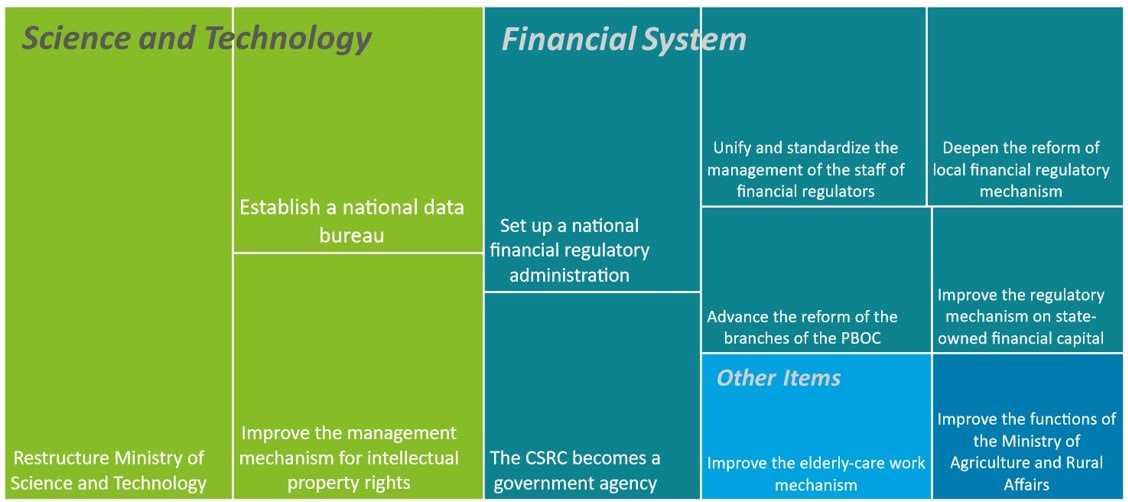
By strengthening the centralized and unified leadership of the center and making science and technology work more forward-looking, systematic and integrated, the restructuring of MOST will improve the efficiency of the application of scientific and technological achievements and the use of scientific and technological funds. The CPC Central Committee will establish a central commission on science and technology, under which the restructured MOST will assume the functions of the commission's administrative body. MOST would undergo a massive revamp that would delegate many of its existing functions to other government bodies like MARA and the Ministry of Industry and Information Technology (MIIT). At the same time, the mechanism of allocating financial science and technology funds will be reformed, instead of participating in the review and management of specific scientific research projects, MOST will be focused on guiding and supervsing the operations and management of specialized scientific research management institutions. Furthermore, MOST will strengthen the supervision and inspection of the implementation of scientific research projects and the evaluation and effectiveness of scientific research results, so as to improve the efficiency of overall science and technology management.
A National Data Bureau will be set up to coordinate the work of array elements, invigorate data resources, and promote the healthy development of the data elements market. After the latest round of institutional reform, provincial data management institutions have been established in Guangdong, Fujian, Zhejiang, Guizhou and other provinces. At the national level, however, a dedicated department to co-ordinate data resources has yet to be created. The establishment of the NDB was proposed in these reforms, reflecting the intention to centrally coordinate work concerning digital elements. To invigorate data resources, the new government will bolster the circulation and transaction of data from the top-level design, which is also conducive to building a healthy data elements market.
The CNIPA returns to an institution directly under the State Council, which elevates the status of IPR in national governance. The move will improve the efficiency of the formulation and promulgation of administrative regulations in IPR, so that new problems and challenges can be dealt with more quickly. In addition, the State Administration for Market Regulation (SAMR) will retain enforcement duties around trademarks, patents and other fields, while CNIPA is responsible for the work related to affirmation of rights. This reflects the reform intention to clarify work division and promote collaboration.
The new government will strengthen the overall coordination in financial regulatory, reduce overlap and gaps in regulation, prevent and defuse local financial risks. After the reform, the China Banking and Insurance Regulatory Commission will no longer be retained, and the newly established NFRA is uniformly responsible for the supervision of the financial industry except the securities industry. The CSRC was assigned the function of issuing and examining corporate bonds. The reform continues the trend that financial regulation transfers from 'separate' to 'comprehensive' since 2017. Also, the establishment of the local financial supervision system dominated by local agencies of the central financial regulatory department and the enhancement of central supervision over local financial regulators will be conducive to carrying out penetrating supervision and preventing and defusing local financial risks.
In areas concerning people's livelihoods and social affairs, the adjustment of the NPCPA to become an institution directly under the State Council and the leadership of the central department for social work shows the intention to strengthen coordination work in public complaints and proposals. The State Council has placed national-level petitions in its daily work to better listen to the thoughts and feedback from the people. In addition, work on senior citizens has been reassigned to the MCA system after being assigned to the NHC five years ago. The MCA takes the lead in the overall work as the NHC mainly takes charge of work related to elderly healthcare, which is conducive to work division and coordination and comprehensively promoting the development of the undertakings for the elderly.
Five key issues affect industrial transformation and upgrading.
This year's Report on the Work of the Government follows the spirit of the Report to the 20th CPC National Congress and the Central Economic Work Conference, which reflects the coherence and consistency of the government's policies. The report continues to stress the importance of the real economy. On stability, the emphasis will be placed on ensuring stable growth, stable jobs and stable prices. Financial services in the real economy and the deep integration of the digital economy and the real economy will contribute to the transformation and upgrading of China's economic growth model and industrial development. In the medium to long term, five key issues, as important connotations of the new development pattern, will have a far-reaching impact on the industry's development – high-quality development, scientific and technological innovation, green and sustainable development, strategic security and stability, and common prosperity. In this context, we can see that the consumption-driven economic growth model will further promote the integration of science and technology and consumer industries, and give birth to new business forms, models and markets. The scale of the consumer retail industry will continue to grow. Meanwhile, the further formation of fair market approaches will bring more fierce competition to the industry, and the
"green premium" will become a new competition barrier. The emphasis on independent research and the development of core technologies will accelerate the pace of domestic substitution in key industries, and specialized and sophisticated enterprises with technology-leading advantages in vertical markets will get more support from policies, capital and other aspects. The security of industrial chains and supply chains, energy security, data security and financial stability will become the bottom line so as to effectively upgrade and appropriately expand China’s economic output. Security concerns will rise to a strategic level and will also affect business models, especially the management and control of compliance processes. The green transformation and decarbonization of key industries will also establish clear road maps moving forward. With increasing investment in green and low-carbon technologies, foreign companies with leading practices can collaborate with local companies to help their industry achieve peak carbon emissions and carbon neutrality. The balanced consideration of supply chain efficiency and safety, along with the coordinated regional development in China, will also affect the supply chain layout of the industry in the local market. In addition, the intensification of domestic competition in specific industries and the slowing growth of market demand are also driving leading enterprises to expand business opportunities overseas.
Manufacturing: balancing security and opening-up, accelerating digital and green transformation
The government’s working report mentioned the promotion of upgrading traditional industries, cultivating and strengthening strategic emerging industries, and focusing on strengthening the weaker elements of the industrial chain as priorities for 2023. The new government’s leadership has also publicly stated that China’s focus on high-quality development will be shifted from providing people’s basic needs towards delivering a better life quality for the people. The government will implement its strategy in multiple areas, particularly by improving technological innovation, building a modern industrial system and promoting green transformation. In this context, the opportunities and challenges facing China’s manufacturing industry mainly include:
Opportunities
- Self-reliance will foster a group of world-class enterprises as industrial chain leaders. China is directing its best resources towards achieving breakthroughs in key technologies. This will enhance the synergy of industrial chains within industry clusters, and also cultivate a group of world-class enterprises that lead or dominate industrial chains on a national or regional scale.
- Small and medium-sized manufacturing companies specialized in technologies are on the fast track to success. These companies are expected to receive policy support, which will accelerate their R&D, capacity for expansion, financing, public listing, and digital transformation.
- Traditional manufacturing and SMEs will accelerate digital and green transformation. The construction of a modern industrial system promotes the digital transformation of traditional manufacturing and SMEs, enabling them to extend their business along upstream and downstream value chains to capture higher value, and drives the decarbonization of their operations and supply chains.
- Intensified efforts to attract foreign investment are expected to stabilize growth. The government may strengthen policies to attract foreign investment in advanced manufacturing and the launch of landmark foreign-funded projects.
Challenges
- Resurgence of global manufacturing affects China’s international trade and investment. Major countries are ramping up their supply chain security measures by limiting or prohibiting technology exports and promoting domestic production, which has been compounded by geopolitical frictions, creating an unfavorable environment for China’s international trade and cross-border investment.
- New sustainability regulations increase compliance risks and operational costs. The new wave of ESG and sustainability regulations being announced and implemented in multiple regions may lead to a significant increase in short-term pressure on enterprise operations and supply chain decarbonization.
Figure: Industry distribution of "Little giant" enterprises

Figure: “Little giant” enterprises in capital markets
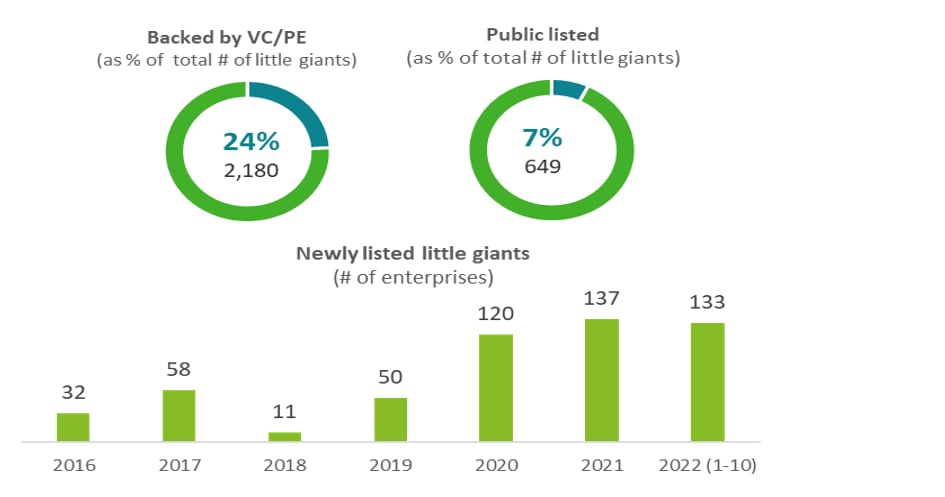
Financial support for consumption, bank spreads to stabilize, and enhanced importance of capital markets
The 2023 Government Work Report emphasizes that prudent monetary policy should be precise and strong, which is a more neutral expression than in 2022. The degree of monetary easing will decrease, market interest rates are expected to stabilize, and bank spreads may end the declining trend for four consecutive years during 2019-2022.“
Focus on expanding domestic demand” takes priority, with consumption and investment as the backbone to supporting the economic recovery. Infrastructure investment, manufacturing and green finance continue to be key areas.
The importance of credit growth is reduced, without mentioning the growth target. As traditional real estate and other capital-intensive credit demand have weakened, credit growth will probably enter a period of low growth, while insisting that M2 and TSF growth rate basically match with nominal GDP, and with TSF growth below 10% perhaps becoming the norm.
The Bureau of General Administration for Financial Supervision has been established to coordinate oversight of market behavior to effectively prevent and defuse major financial risks. Based on the Financial Stability Law, resource inputs to the financial stability guarantee fund, the deposit insurance fund and the industrial guarantee fund shall be arranged as a whole in risk disposal. There is also a need to defuse risks from "high-quality real estate enterprises" and local government debt.
Regulatory functions for capital markets are strengthened. CSRC manages the issuance and review of enterprise and corporate bonds in a unified manner, and capital markets are expected to operate in a more standardized and efficient manner.
Chart: Bank spread likely to stabilize in 2023 after narrowing to historic lows in
2022
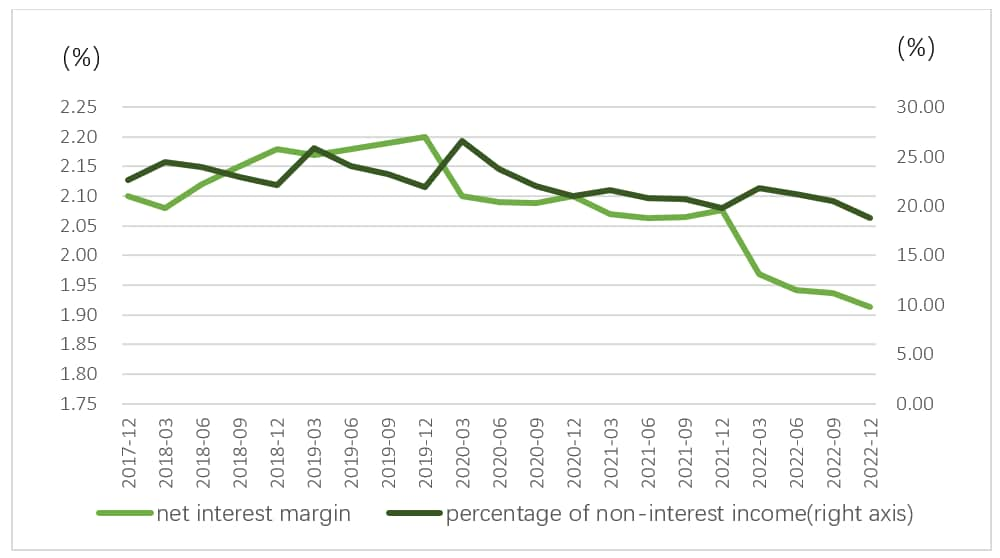
Source: PBC, Wind
Opportunities
- Financial support to expand consumption will be a top priority, which will lead to an increase in consumption credit facilities.
- There will not be a credit growth target for 2023. Interest rates will stabilize under a neutral monetary environment. Pressure on bank spreads will ease. Inclusive loans issued by large banks might marginally decrease, while small and medium-sized banks have ushered in incremental market space.
- CSRC will become the direct subordinate to the State Council, showing the enhanced importance of capital markets. Direct financing will further develop, and investor rights will receive more attention.
Challenges
- Effectively resolving major financial risks will be emphasized. Banks with large loan exposure to real estate and local government debt continue to be under pressure of capital erosion.
- The Bureau of General Administration for Financial Supervision will coordinate the improved efficiency of micro-prudential and behavioural supervision, demanding higher requirements from financial institutions in terms of the protection of the rights and interests of financial consumers and investors.
Auto: Regain growth momentum in the short-term while leapfrogging through innovation, digitalization, and the green transition in the long-term
The new Government Work Report has set the tone for the development of the automotive industry this year, which will center around three aspects: stabilizing consumption, modernizing industry and opening up further.
"Restoring and expanding consumption" has been established as a top priority for the Chinese government this year which stressed the importance of stabilizing the consumption of big-ticket items such as automobiles. Secondly, as part of China's endeavour to modernize its manufacturing industry, the automotive sector will play a pivotal role in this. The focus of this year's policy will centre on continuing to promote the development of new energy vehicles, achieving self-innovation in key technologies and components, exploring the domestic supply of strategic minerals, accelerating both the digital and low-carbon transition of enterprises, and attracting and utilizing more foreign capital.
Opportunities
- Efforts to achieve greater self-reliance in key technologies will boost the growth of domestic supply chains and local giants. Future policies are expected to support R&D and the commercialization of key technologies such as next-generation batteries, automotive chips and operating systems such as through special tasks and guidance funds, providing an essential boost to local "little giants" in niche markets.
- Striving to ensure supply chain resilience will accelerate local mining of critical minerals used in electric vehicles. The government is expected to encourage private capital to invest in the domestic exploration and mining of strategic minerals, as well as to launch pilot projects in the circular economy around key resources to secure sustainable supply.
- Acceleration of digital transformation within automotive sector. Auto OEMs will step up investment in digital transformation, mainly by expanding the scope and depth to achieve end-to-end transparency and synergy across the entire supply chain, and to support the intelligent and predictive decision-making of enterprises.
- Commitment to high-level opening-up to reassure foreign investors. The government is expected to create a better investment environment through various aspects such as protection of intellectual property rights, cross-border talent flows and cutting red tape to attract foreign car companies to set up R&D centers, as well as to invest in advanced manufacturing in China.
- Green transition brings new investment opportunities. Under pressure from ESG compliance, auto OEMs are expected to collaborate with upstream and downstream suppliers to increase investment and accelerate large-scale application of low-carbon products, technologies, processes and business models.
Challenges
- Squeezed margins due to a lower-than-expected consumption recovery and intensified competition. In the absence of nationwide stimulus policies, the automotive industry is generally caught in a price war, and the short-term performance of auto OEMs will be under pressure. In addition, the complexity and uncertainty of investment in emerging technologies will also have a negative impact on corporate profitability and will affect the strategic determination of long-term investment.
- Increased difficulty and cost of data compliance in an era of tightened regulation. Detailed regulations on data and cyber security and privacy protection in both domestic and foreign markets has increased the difficulty and cost of data compliance in all aspects of automotive enterprises, from R&D, sales, supply chains and production.
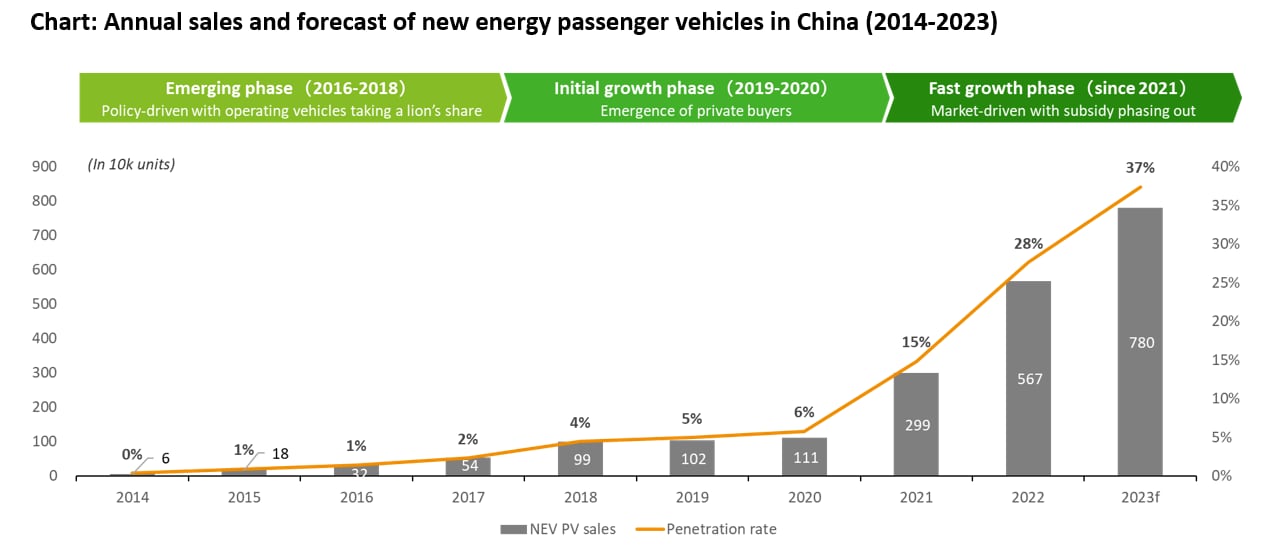
Data source: CPCA, Deloitte Research
Technology, Media and Telecommunications: Realizing “self-reliance” in advanced technology while creating a “full-digital” nation
The recently released "Digital China" and the Government Work Report at the Two Sessions conveyed to the public that China will continue to strengthen self-reliance in high-level science and technology, vigorously promote the digital economy that fully integrates digital and industry, while becoming an advanced digital nation with strong digital culture and a green digital ecosystem.
Industry Opportunities
- The key theme for the tech industry going forward is domestic substitution: In order to break foreign technological monopolies and establish a domestic manufacturing industry chain, breakthroughs are anticipated in the development of key sectors including artificial intelligence (AI), quantum computing, integrated circuits, high-end chips, operating systems, industrial software, and fundamental hardware and software.
- AI will deepen its impact on a variety of industries: AI will be better integrated with scientific research, more scenario-driven, and user needs will be applied in a variety of sectors, including energy, healthcare, autonomous driving, aerospace, agriculture, industry, and supply chains, all of which are future focus areas.
- The construction of new digital infrastructure is developing rapidly: China has constructed the world’s largest 5G network, and the next step is to broaden 5G's applications and strengthen its integration with the manufacturing sector. Meanwhile, satellite communications and 6G R&D will increase in pace. Computational power and cloud data centers are also critical to the development and success of "Digital China".
- The market for data security is expected to prosper: Data security will be elevated to the status of a national security strategy under the newly established National Bureau of Data of China, which unifies the management of digital elements. The entire data lifecycle process, which encompasses data security management systems, data security technology research and development, data security risk detection and security risk assessment, will promote all-around development.
- The technology sector's talent acquisition framework will be improved: The 20th CPC National Congress noted that by bolstering the nation's strategic technological strength, talent introduction policies will become clearer and more effective in the near future. China will also establish a favorable environment for scientific research, and a talent system that is competitive on a global scale at the same time.
Figure: China's industrial digitalization size and projections (RMB trillion, 2020-2025E)
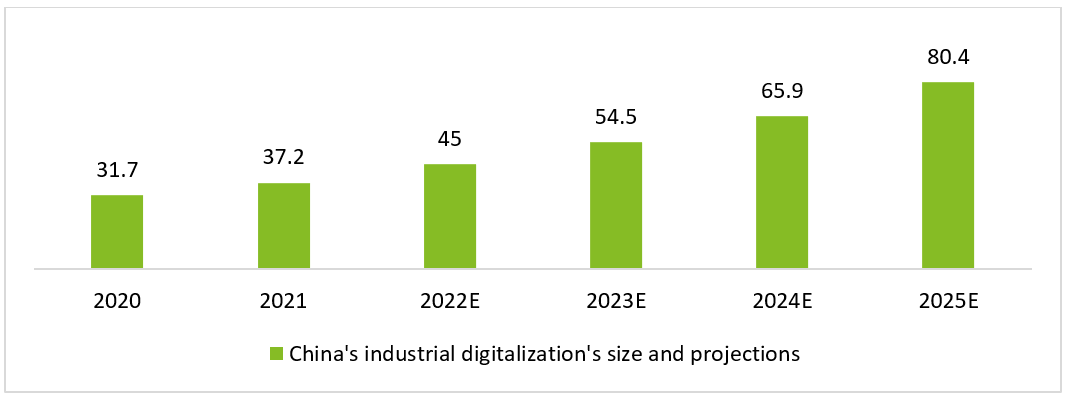
Source: China Digital Economy Development Report, Chinese Academy of Social Sciences, Deloitte Research
China's data security market size (RMB billion, 2021-2025)

Source:Government publication, Askci, Deloitte Research
Challenges
- Supply chain security lacking. Due to the increasingly uncertain geopolitical conditions, companies now have to deal with a series of unpredictable situations such as higher prices, product shortages and cyber-attacks. China needs to strengthen domestic R&D substitution (such as the supply chain of semiconductors) and reduce its dependence on foreign imports to deal with potential risks.
- Lack of cutting-edge talent in the technology industry. China has made great achievements in scientific and technological development, investment and personnel training. But it is also facing issues such as the lack of major original achievements, and a lack of top talent and funding which may hamper its goals of achieving greater self-reliance.
- Technology companies may face financing difficulties. Due to the high investment and long cycle of technological innovation, these companies face strict risk monitoring and are prone to fall into financing difficulties.
- Issues with energy consumption for new digital infrastructure. The digital economy has driven a significant increase in energy consumption in data transmission, storage, computing, application links, and interconnected equipment, and a large amount of waste such as old equipment and batteries has also been generated which needs to be properly disposed of. These factors pose challenges to green and low-carbon development.
Energy and Resources: Sticking to the dual goals of security and the clean transition
Security and the clean transition are still the two key themes from the energy and resources sector of the Government Work Report. Reduction of fossil fuel consumption was listed as one of the main targets, and the report also touched on several priorities for subsequent work this year including “redoubling efforts to explore and develop important energy and mineral resources”, “promoting R&D for the clean and efficient use of energy” and “developing the circular economy”. In this context, China’s energy and resources sector is facing opportunities as well as challenges. These mainly include:
Opportunities
- Clean energy will continue to accelerate: As fossil fuel consumption will be restricted, the share of renewable energy in China’s energy mix is expected to increase. Oil and gas companies will reposition themselves as integrated energy companies by investing in or acquiring clean energy assets and ramping up high-end petrochemical production.
- The next generation of power systems will enable new business models: Along with the development of the digital transformation, the power system is shifting from one-way dispatching to multiple interactions, which will increase the visibility of data, energy and carbon, and accelerate the commercialization of new business models such as shared energy storage and digital EaaS platforms.
- The circular economy links the energy transition to resource utilization: The upcycling of raw materials for renewable energy and carbon help to reduce emissions and alleviate the pressure of resource supply. Therefore, it will be a vital pillar in the sustainable development of the renewable energy industry.
Challenges
- The clean transition drives compliance costs up: Fossil fuel companies need to seek advanced technologies that enable the efficient and clean use of fossil fuels as well as digital technologies to achieve sustainable development.
- Increased technical difficulties and drilling costs: The future potential of oil and gas discoveries exists mainly in offshore and unconventional scenarios. This may bring new challenges to drilling technology and production costs.
Figure:Average Breakeven prices by production source in 20211
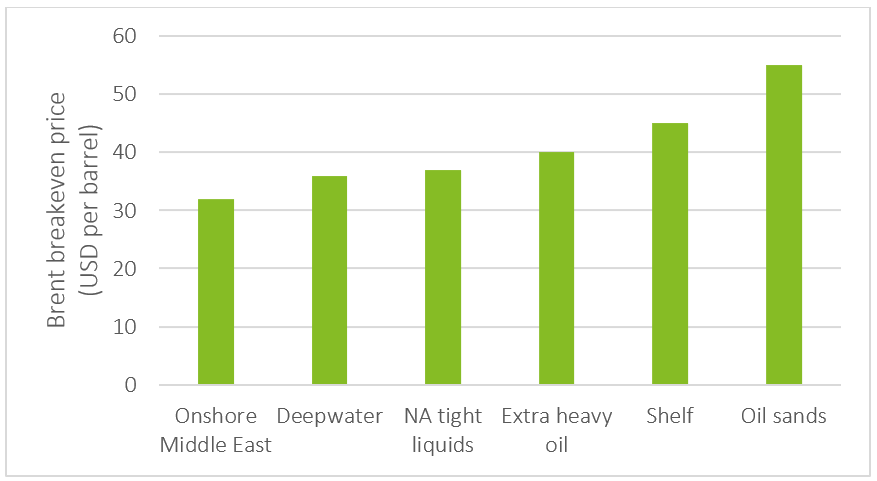
Source:Rystad Energy,Deloit
Life Science & Health Care (LSHC): Continue to cultivate Healthy China and promote the innovation upgrade
In the latest Government Work Report, the promotion of the Healthy China initiative has been further emphasized on the back of the 14th Five-Year Plan (14FYP) and the 20th National Congress. Furthermore, the deepening of the reform process of the medical and health system has also been brought up again in order to solve the issue of "hard access and expensive medical treatment". There are six major focus areas: 1) promote the sinking and balanced coverage of medical resources to optimize the medical distribution; 2) increase the support for original innovation, and achieve breakthroughs in frontier fields such as novel antibodies and CGT; 3) actively and effectively use foreign investment by optimizing the foreign investment environment and build up international innovation centers with the goal of eventually establishing a world-class LSHC innovation cluster; 4) expand the application scenarios of medical services and achieve more specialized and personalized medical care through the combination of smart and internet technologies; 5) promote regional coordinated development, strengthen the development of the high-tech industry (including biotechnology) and the layout of the whole industrial chain in the region; 6) adhere to the coordinated development of TCMs and western medicines, and satbilize output support and the application of TCM R&D and innovation.
All in all, the main opportunities and challenges in the China LSHC industry are:
Opportunities
- The development of smart healthcare will be further upgraded. Especially the diversified application of AI in R&D, manufacturing, and medical treatment. In the future, it is expected that more local digital technology firms will establish in-depth partnerships with medical institutes and life science enterprises. Meanwhile, the application of digital technologies in public health management will also be increased.
- Sinking medical resources to achieve wider coverage of medical services. With the sinking of medical resources and the improvement of informatization, the application of telemedicine has been enhanced. The imbalance of medical resources in the central and western region will be gradually resolved, resulting in expansion opportunities in the market space for private medical institutes.
- Continuously increasing support for innovative assets, resulting in a brighter outlook for innovative pharmaceutical and medical devices companies. The market access of innovative assets has been accelerated under the release of preferential policies. Meanwhile, the support for basic research and the commercial transformation of innovation research has been increased. The benefits from the supportive policies of homegrown products also accelerates the localization of foreign-funded enterprises.

Challenges
- Shortened economic value window for innovative assets. From the dynamic adjustment of the National Reimbursement Drug List to the normalization of volume-based procurement, then to the deepening of the Diagnosis Related Groups and Diagnosis-Intervention Packet (DRG/DIP) payment reform, the pricing of innovative assets will experience multiple rounds of sharp reductions in the short term. This will result in frequent adjustments to the pricing strategy. Moving forward, pricing pressures for pharmaceutical and medical devices companies will rise under the continuous promotion of the medical pricing reform.
- Stricker regulatory landscape is driving higher compliance requirements for LSHC companies. With the continuous improvement to regulations concerning data and the storage and utilization of human-gene related information, R&D compliance costs have increased and more resources will need to be invested to improve the compliance system for all players in the industry.
Consumer and retail: boosting domestic demand by prioritizing the recovery and expansion of consumption
The Government Work Report in 2023 emphasized that efforts should be made to expand domestic demand and that the recovery and expansion of consumption should be given priority. This year's Two Sessions delivered positive policy signals around high-quality development, innovation, green, security and urbanization. The opportunities and challenges of the consumer goods retail industry are reflected in the following aspects:
Opportunities:
- The measures to boost consumption are expected to further improve the sales performance of the industry. The report proposes to increase the income of urban and rural residents through multiple channels to stabilize consumer spending on big-ticket items and services. With the recent package of policies to boost consumption, it is expected that household appliances, catering and tourism will take the lead in the recovery.
- High-level opening-up may boost a new round of cross-border ecommerce and M&A. The report proposes to strengthen the opening of the modern services industry and continue to play the role of import and export in supporting the economy. 2023 may see more consumer goods and retail enterprises will be expected to expand their businesses via channels such as cross-border ecommerce and M&A.
- The rapid development of new formats and models will promote the continuous expansion of the industry scale. The report stressed the need to strengthen the leading role of scientific and technological innovation, vigorously develop the digital economy, and accelerate the digital transformation of traditional industries and small and medium-sized enterprises. With the help of digital technologies, enterprises can accelerate the innovation of business forms and models, expand business boundaries, and promote the continuous expansion of the industry scale.
- "Green premium" will accelerate the overall green and low-carbon transformation of the industry. The report indicated that China should promote the green transformation. With the popularization of the concept of green and low carbon in the consumer sector, consumers gradually take green and low carbon as a key consideration in their consumption preferences, which will further enhance the urgency of green transformation of enterprises.
- Rising consumption demand in lower-tier cities and rural area will bring new increment to the industry. The report highlighted the promotion of new urbanization and rural revitalization. With the continuous promotion of income levels in counties and rural areas, the huge consumption potential of lower-tier cities and rural areas will provide new growth for the industry.
Figure: Online sales of consumer goods keeps expanding
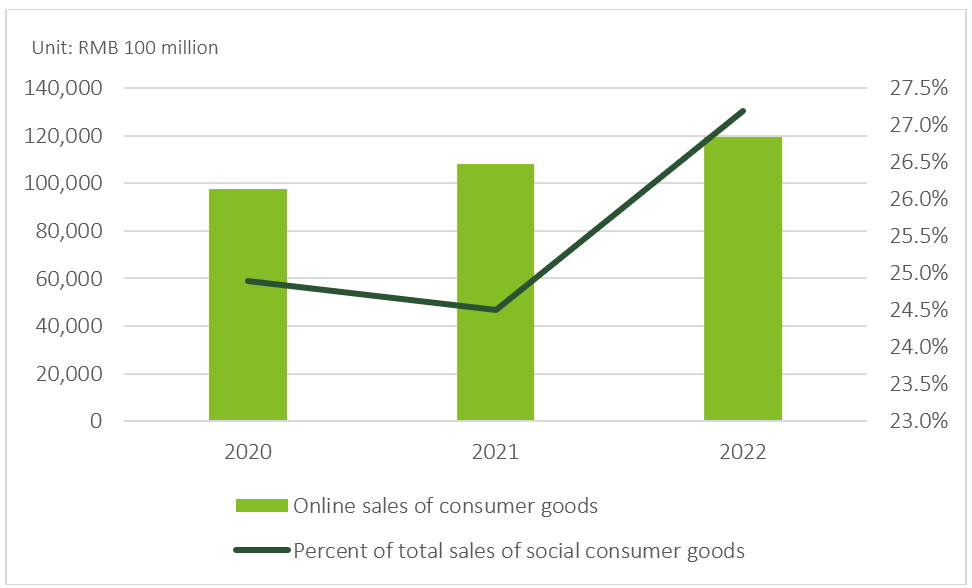
Source: National Bureau of Statistics
Figure: Sales across various categories went up in the first two month of 2023
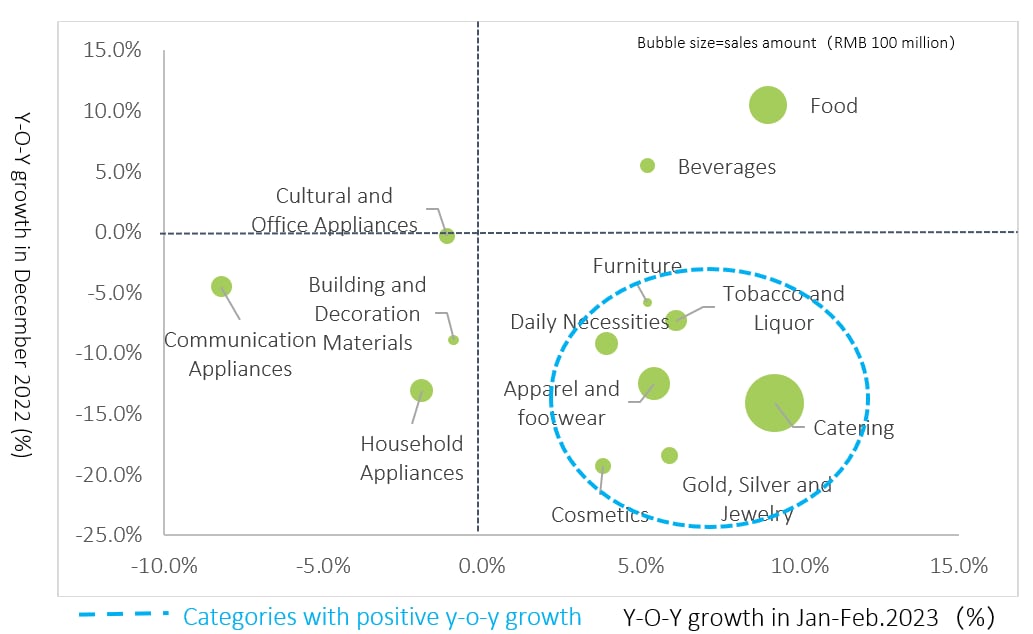
Source: National Bureau of Statistics
Challenges:
- Industry faces more fierce competition: The expansion of opening-up will further reduce the barriers to domestic market access such as tariffs, and industry competition will intensify accordingly.
- Increased cost of green transformation: As a high emissions industry, the cost of carbon reduction for the consumer products and retail industry in the production and logistics process may increase.
- Rearranging supply chains may cause short-term cost pressures on enterprises: Uncertainty in the international market urges consumer products and retail enterprises to increase intelligent, flexible production and supply chain rearrangement to counter the impact of unexpected factors, and the profits of enterprises may come under pressure in the short-term.
- Increased compliance costs of enterprises: Data security requirements have been further improved, and higher compliance requirements have been put forward for key platform enterprises that master consumer privacy and consumption data, and the related costs of enterprises may be further increased.